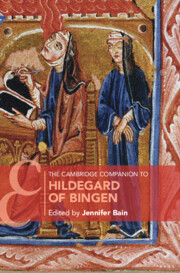Book contents
- The Cambridge Companion to Hildegard of Bingen
- The Cambridge Companion to Hildegard of Bingen
- Copyright page
- Dedication
- Contents
- Figures
- Tables
- Music Examples
- Contributors
- Acknowledgments
- Introduction
- Part I Life and Monastic Context
- Part II Writings and Reputation
- Chapter 4 Hildegard of Bingen’s Theology
- Chapter 5 Reading Hildegard of Bingen’s Letters
- Chapter 6 From the Roots to the Branches: Greenness in the Preaching of Hildegard of Bingen and the Patriarchs
- Chapter 7 Hildegard of Bingen: Illness and Healing
- Chapter 8 The Pentachronon and Hildegard of Bingen’s Reputation As a Prophet
- Chapter 9 The Context and Reception of Hildegard of Bingen’s Visions
- Part III Music, Manuscripts, Illuminations, and Scribes
- Select Bibliography
- Index
- Cambridge Companions To …
- References
Chapter 4 - Hildegard of Bingen’s Theology
from Part II - Writings and Reputation
Published online by Cambridge University Press: 28 October 2021
- The Cambridge Companion to Hildegard of Bingen
- The Cambridge Companion to Hildegard of Bingen
- Copyright page
- Dedication
- Contents
- Figures
- Tables
- Music Examples
- Contributors
- Acknowledgments
- Introduction
- Part I Life and Monastic Context
- Part II Writings and Reputation
- Chapter 4 Hildegard of Bingen’s Theology
- Chapter 5 Reading Hildegard of Bingen’s Letters
- Chapter 6 From the Roots to the Branches: Greenness in the Preaching of Hildegard of Bingen and the Patriarchs
- Chapter 7 Hildegard of Bingen: Illness and Healing
- Chapter 8 The Pentachronon and Hildegard of Bingen’s Reputation As a Prophet
- Chapter 9 The Context and Reception of Hildegard of Bingen’s Visions
- Part III Music, Manuscripts, Illuminations, and Scribes
- Select Bibliography
- Index
- Cambridge Companions To …
- References
Summary
Conceptualizing Hildegard of Bingen as a theologian has been impeded by a pervading focus on her visionary status. The author provides a fruitful reassessment of Hildegard’s theology by contextualizing her writings along three coordinates: the authoritative texts she cites, the institutional environment in which theological discussion takes place, and the audience to whom the theology is directed. Her responsibility as magistra of her community led her to construct her trilogy of visions – Scivias, Liber vitae meritorum, and Liber divinorum operum – not just as visionary writings for the broader church but as a structured theological system to aid her nuns pedagogically. Analysis of her writings reveals a systematic methodology of theological instruction, including her use of classical rhetoric; additionally, her concerns for her nuns’ spiritual welfare are reflected in a customized presentation of theological topics. Ultimately, understanding Hildegard’s theology as a direct response to her immediate community reframes it and highlights its similarities to twelfth-century methods of theological instruction.
Keywords
- Type
- Chapter
- Information
- The Cambridge Companion to Hildegard of Bingen , pp. 85 - 104Publisher: Cambridge University PressPrint publication year: 2021



